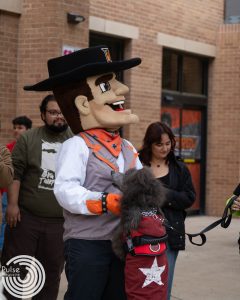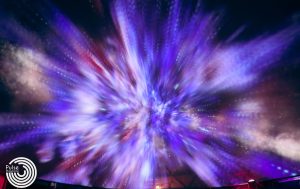Rio Grande Valley to Witness 2023 and 2024 Solar Eclipses
Graphic by: JC Marquez
On Oct. 14, an annular solar eclipse will happen over Texas. On April 8, 2024, Texans will be able to witness a sequel in the form of a total solar eclipse. These rarely-seen phenomena will be the last solar eclipses visible from the United States until 2039.
Annular vs. Total: What’s the Difference?
According to NASA, an annular solar eclipse occurs when the moon passes between the Earth and the sun while at or near its farthest point from Earth, thereby appearing smaller in the sky and creating what looks like a ring around the moon.
A total solar eclipse darkens the sky and reveals the sun’s corona, its halo-like outer atmosphere, for a few minutes while the moon completely covers the face of the sun. Viewers outside the narrow paths of annularity and totality will only witness a partial solar eclipse.
Timeline of the Annular Solar Eclipse
According to NASA, the Oct. 14 annular solar eclipse will pass through Texas diagonally, starting from Midland and ending at Corpus Christi, including the cities of West Odessa, Kerrville, San Antonio and Kingsville. These areas will perceive 90 percent coverage of the sun by the moon, while the rest of Texas to the north and south, including the Rio Grande Valley, are projected to see partial eclipses with 75 to 85 percent coverage.
The annular eclipse process will open with a partial eclipse around 10:23 a.m. At this time, the moon will begin to pass over the sun. Annularity is set to begin at 11:52 a.m. when the moon passes completely in front of the sun creating what looks like a “ring of fire” for up to five minutes. The remaining partial eclipse is expected to conclude by 1:33 p.m.
How to Protect Your Eyes While Viewing
The sun is never fully covered during an annular eclipse, so eye protection must be worn during the entire viewing.
According to NASA, “Regular sunglasses, no matter how dark, are not suitable for direct solar viewing. You must use specialized eclipse glasses or a filter rated for direct solar viewing to see this eclipse. … Do not look at the sun through a camera lens, telescope, binoculars, or any other optical device while wearing eclipse glasses or using a handheld solar viewer — the concentrated solar rays will burn through the filter and cause serious eye injury.”
NASA also recommends frequently looking away from the sun while viewing, to avoid overheating the fluids in your eyes.
Chelsea Lyssy, coordinator for the H-E-B Planetarium at UTRGV, said that phone cameras are not a substitute for proper protection.
“I do not recommend that you use your cell phone or camera or anything like that because it can mess up the lens. … You have to have a filter to view it with your phone.”
The April 8, 2024 eclipse will offer a brief phase of totality, during which special eclipse glasses are not necessary.
Timeline of the Total Solar Eclipse
During the April 8, 2024 total solar eclipse, the path of totality in Texas will run diagonally from Eagle Pass and Del Rio to Arlington and Dallas, passing over the cities of San Antonio, northwestern Austin and Waco, among others.
The partial eclipse phase will begin around 12:23 p.m., developing into totality by 1:40 p.m. and concluding approximately at 1:44 p.m. The remaining partial eclipse is expected to end at 3:02 p.m.
Various unique sights become visible during a total solar eclipse. Long, faint bands of shadows called “shadow bands” show up just before and after totality, moving quickly along the ground or the sides of buildings. “Baily’s Beads,” brief peeks of the sun’s light from along the uneven horizons of the moon, disappear one by one until the “diamond ring” effect occurs, in which the last bright spot shines and disappears just before totality.
During totality, no direct sunlight is visible, and the sky darkens. The chromosphere region of the sun’s atmosphere will appear as a pink ring around the moon. The sun’s corona will show as “streams of white light.”
NASA noted other occurrences common for a total eclipse:
“During totality, take a few seconds to observe the world around you. You may be able to see a 360 degree sunset,” NASA said. “You may also be able to see some particularly bright stars or planets in the darkened sky. The air temperature will drop and often an eerie silence will settle around you. It is also worth stealing a peek at the people around you – many people have a deep emotional response when the sun goes into totality.”
Radio broadcasts and satellite signals will experience disruptions during the eclipse, due to the sun’s effects on the atmosphere.
Additionally, many animals become confused by the change. Nocturnal animals may awaken while diurnal animals prepare for sleep.
However, this phase is short-lived. After totality, the “diamond ring” emerges again as the moon slides away from the sun, revealing more beads of light until the partial eclipse phase returns for the last time.
Where to Watch in the Rio Grande Valley
Ahead of the Oct. 14 annular eclipse, the McAllen Public Library is hosting daily eclipse-themed events for children, teens and adults, offering free solar eclipse glasses to attendees. Additionally, a viewing party will take place from 11:30 a.m. to 12:30 p.m on Oct. 14 at the library’s main location. The library will not provide eclipse glasses.
Other organizations throughout the Rio Grande Valley have announced their own viewing parties scheduled for Oct. 14.
The H-E-B Planetarium will host a solar eclipse viewing party 10 a.m. to 3 p.m. at the sundial on the UTRGV Edinburg campus. The event is free and open to the public. The planetarium will provide solar eclipse glasses on a first-come, first-serve basis.
This is part of the 60th anniversary celebration of the planetarium’s construction. Multiple activities will be held aside from the viewing party, including a talk given by Nicolas Pereyra, UTRGV professor for Physics and Astronomy; the screening of educational videos inside the Planetarium’s dome; and live streaming of the solar eclipse in one of the classrooms and on a TV screen near the rotunda of the science building.
The Dustin Michael Sekula Memorial Library in Edinburg will hold a viewing party from 10 a.m. to 12:30 p.m. on Oct. 14, offering solar eclipse glasses for free.
The South Texas Astronomical Society will partner with the Brownsville Public Library to hold a free-of-charge viewing party at the library’s Southmost branch. The library will provide eclipse glasses, hold STEM activities and host several vendors and speakers.
People can also catch NASA’s live stream of the eclipse on YouTube.








